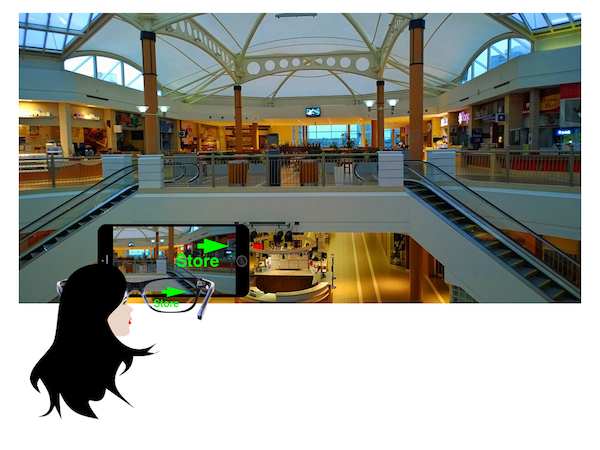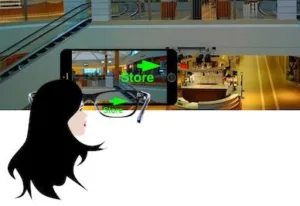AR here, VR there, these days it seems that we cannot discuss any technology development without hearing how AR and VR will change not only consumer electronics but all life as we know it.

Since we are getting to the end of 2017, I want to summarize how I see the development of AR and what I feel will come down the road.
Worldwide Interest in AR / VR
When we take a look at the worldwide interest in AR and VR, Google Trends is a good indicator based on the frequency that these terms appear in any Google search. The charts show how the relative search frequency for AR and VR has changed over the last two years. The red line represents the search term “VR”, while the blue line shows the results for the term “AR”.
As it seems, augmented reality beats virtual reality by a 2 to 1 margin most of the time. There are spikes in the search times with the most interest in virtual reality around last year’s holiday season (and, of course CES – Man. Ed.). It may be a good bet that we will see a similar trend this year with the prices for VR headsets and PCs coming down and many more manufacturers entering the market.
This search frequency does not seem to make a lot of sense, as virtual reality headsets were actually available in the market and interest should have been higher for VR. However, AR is what seems to interest people more. This raises the question of whether they actually know what they are looking for?
 Worldwide Interest in AR and VR
Worldwide Interest in AR and VR
From a geographical perspective, VR seems to generate more interest than AR in Russia, Canada and most of Europe and Asia. On the other hand North- and South- America as well as India and Malaysia show more interest in AR.
If AR is already generating more interest than VR without even being in the market, that should be a good sign for the potential of augmented reality with consumers. Right?
What is AR?
Let me first define what I believe AR is and take it from there. Other people may have a different view, which shows that, today, we are still far from a consensus definition on the terms.
Augmented reality overlays information over the real world to enhance the users perception of reality. Virtual reality on the other hand blocks the wavefront coming from the real world with an image on a digital display. So far this is a clear distinction between AR and VR. AR adds information to the wavefront coming from real world objects while VR replaces this wavefront completely. In other words, AR uses a transparent or semi-transparent display, while VR uses a non-transparent display.
What if the VR system provides an image of the real world on the display and adds additional information to it? The effects would be very similar to an AR system for the user.
 What is AR?A device-centric view would call the glasses an AR system, while the smartphone based solution would be called VR, even though both show pretty much the same information. To make matters worse, both Google Android and Apple are calling their software support packages “ARCore” and “ARKit” respectively. We can expect that apps based on these kits will be called AR-something. On top of this, the Samsung Gear VR puts the same smartphone in a piece of plastic and calls it a VR headset. Confused yet?
What is AR?A device-centric view would call the glasses an AR system, while the smartphone based solution would be called VR, even though both show pretty much the same information. To make matters worse, both Google Android and Apple are calling their software support packages “ARCore” and “ARKit” respectively. We can expect that apps based on these kits will be called AR-something. On top of this, the Samsung Gear VR puts the same smartphone in a piece of plastic and calls it a VR headset. Confused yet?
As a consequence we already have two definitions of AR that the consumer has to understand. To be fair, most writers and analysts today will include the smartphone version of AR as a real AR solution, however, hardware-centric definitions may not. Market forecast data will require a clear definition of the terms in order to be useful. For example, if we include the smartphone version of AR in the AR market forecast, does that mean that smartphones are also part of the AR hardware market?
A similar situation exists for head up displays in cars. From a hardware perspective, every HUD that uses a reflective surface (windshield or separate screen) is an AR device as it adds information to the real world view in form of speed, rpm, warnings, etc. However, most providers differentiate between a HUD and an augmented reality HUD. The second version adds location sensitivity to the provided information.
If we think of navigation, first generation HUDs just showed a turn arrow in the screen area of the HUD, while the AR HUD will overlay the directional information on the appropriate turning lane in the driver’s view. It’s a small difference in terms, which is driven by the possibility of eye tracking technology to establish the correct position of the projected image. This issue also exists in near the eye devices, even though to a much lower extent, as the parallax issue is much reduced based on the smaller distance between the image producing element and the eye.
Since we are talking about what AR is, I need to mention that AR is also a marketing buzzword that helps technology start-ups to get attention that they otherwise would not get. Since everyone in our industry is focused on the next and upcoming technology, this has to be expected. On the other hand, some companies are definitely overusing the term a little bit.
In summary, AR is a technology that can be defined in different ways. We just have to make sure that we when we talk about AR everybody is on board with the used definition.
What AR is Not
While AR holds the promise of becoming a very important information technology in the future, it is by no means a ‘done deal’ as of today. Again, based on the ambiguity of the AR definition as discussed above, certain aspects of AR, such as putting computer generated information on a smartphone, will soon be available to the majority of people, while AR headsets may be many years away from becoming widespread devices.
The first application is a software solution that addresses the most widespread hardware platform in the world, while manufacturers of smart glasses are still developing basic technologies to provide a hardware platform that is attractive to consumers in form and function. Depending on the technology advancements this may take many years to be successful. The best guess is that the time for AR glasses has come when Apple releases its version.
There is nothing wrong with this chain of events. A widespread acceptance of smartphone-based AR may actually drive the development and acceptance of AR hardware solutions in the coming years.
When we think of displays (as we normally do here at Display Daily) AR is NOT the next driver for increased display sales. It may take a decade or more before a display manufacturer decides to build a factory to fill all these display orders for AR glasses.
Don’t get me wrong, I actually love this technology and hope that I will be using this technology extensively in my life time (I will never ever ask for directions again), but sometimes I wish for a little bit more realism when it comes to technology adoption. NH
Analyst Comment
Norbert is keen to avoid the phrase ‘mixed reality’, but that is the term that is being used by some to describe VR headsets (completely enclosed view) that include a camera image to show the real world or part of the real world. There are real challenges in doing this, but that’s a topic for another day. (BR)

